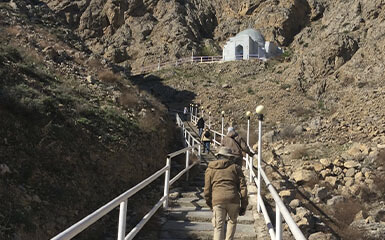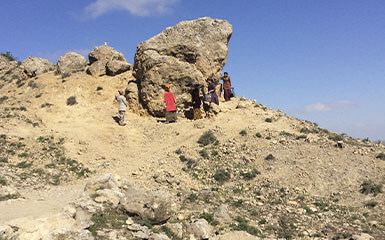Ashgabat
Alem Ferris wheel
State Museum
Fine Arts museum
Wedding Palace
Nisa fortress
Memorial Complex
Ertogrul Gazi Mosque
Neutrality monument
Independence Park
Turkmenbashi Ruhy Mosque
Olympic Village
Ylham Alley
Carpet Museum
Monument of Lenin
Ahal Region
Abivert
Altyn Depe
Annau
Darvaza
Geokdepe
Kowata
Mane baba
Zengi baba
Nedir Shah
Nokhur
Parzdepe
Sarahs baba
Seyit Jemaleddin mosque
Shahrislam
Ulug depe
Mary region
40 cupolas
Akcha Kala
Ancient Merv
Badkhyz
Chilburj
Gebeklytepe
Geok Gumbaz
Gurtly Depe
Kharoba Koshuk
Talkhatan Baba
Yekedeshik
Dashoguz region
Ashyk Aydyn Pir
Devkeshen
Ismamit ata
Kalaly-gyr
Kaplankyr Nature Reserve
Kunya-Urgench
Damla
Balkan region
Dehistan
Yangikala
Awaza
Gozli ata
Kemal ata
Mashat ata
Paraw bibi
Lunar Mountains
Shevlan Baba
Igdy kala
Paraw bibi Shrine

Paraw bibi shrine is in the village of Paraw, in the Serdar district of the Balkan province, on one of the ridges of the Kopetdag. It looks like a small mosque built on a hill from the long distance. Historical evidence indicates that in the XI-XII centuries, the Parawbibi monument was built by the citizens. According to scientific sources, "the word paraw may have come from the Persian word 'feraba', meaning castle."
The fortress of Parav is described in the book "Turkmenistan - the heart of the Great Silk Road" as the fortresses constructed by the Oghuzs at the foot of the desert, on the borders of Khorasan and Dehistan. At that time, along the road from Nisa to Parawa, there were many sources of fresh water and ointments. One of the safest routes was known to be this branch of the Great Silk Road. The caravans were guided to Mashhad-Misserian, the historic site of Turkmenistan. The castle acted as a caravanserai as well. For the archers to rest, there were also the required conditions. The community was mostly interested in the ranching of camels and cattle. Smoky crops on hillsides and mountain slopes were planted by farmers. Crops were irrigated by sewers in the foothills. The outline of the fields is visible when you look at from the foothills of the Kopetdag.
According to popular legend, the officers of the fortress of Parav had six daughters. Although the family is expected to have a son, this time a baby girl was also born. They named her Bibi. Bibi is a Turkmen word for women. Bibi, like her other siblings, was mentally and naturally talented. She learned from experienced physicians how to make medicines and ointments from herbs. Bibi, who has earned a reputation from nature, has gained fame. The news of his miraculous ability spread through the caravans of caravans passing through the fortress of Parav.
The amazing legend about the meeting between Ibn Sina and Parawbibi has passed from word to word and has reached our happy days. At that time Ibn Sina was the chief vizier of the ruler of Khorasan. When he heard of the amazingly capable girl, he joined the caravans of horses and came to the fortress of Parav. When he met Parawbibi, he asked:
"Daughter, how can you diagnose a disease without referring to a book and refer to it?"
"As far as I know you, the information about them seems obvious to me," Parawbibi replied.
According to the legend, Ibn Sina the physician was amazed that a girl had a unique ability and talent. He presented her with a precious ring as a sign of deep respect for her.
In another legend related to Paravbibi, the incident is described as follows: In 1221, Genghis Khan's troops invaded Gurgenji. Then the Mongol commander hears about the doctor girl Parawbibi. He sends a group of horsemen to the fortress of Parav and instructs them to bring her. When there was a battle in the Parav fortress, Mongols conquered. But there wasn’t Parawbibi among the dead and captives in the tragedy; she had gone with her sisters to reap the harvest. Then a woman addresses the enemies of Paravbibi's whereabouts to survive. Paravbibi begins to unleash the melons, which she had gathered with her sisters and piled up, over the approaching enemies. In the meanwhile, she finds the opportunity and leaves her sisters in all directions. She herself is under siege, in a state of emergency, and seeks help from Allah.
"You are merciful, great and honorable!" I would rather die than be taken captive by the enemy and lose my honor! She starts praying Allah. Then the Kopetdag explodes, are opened rocks and gives a land to a poor girl. When she immediately enters between rocks of mountain is closed and that time some hairs of Bibi was left between rocks. When the incident takes place in the eyes of the enemy army, they leave the fort, claiming that there is a miracle here. This legend, through the image of Paravbibi, glorifies the pure morality, loyalty, purity, honesty and courage inherent in Turkmen women.
The Paravbibi memorial can be reached by a winding mountain road dating back to antiquity. As you climb to the top, the air stops and the pleasant smell of mountain grass hits your nose. There is a history of each of the small and large stones on the side of the road. Pilgrims are throwing five stones at the standing position of that filthy woman who showed her whereabouts to the enemies pass by, saying, "Five stones to Sansara." And also tourists can see knees and foot prints of Bibi while she was praying Allah on the stone. Moreover they can explore melon, water melon stones which turned to stone on that incident. Pilgrims say that the images of human feet and hands on the surface of frozen stones in a small cave belong to Paravbibi. If you place flat stones here on your fingers, they will rotate gently. Pilgrims see this as a fulfillment of their dreams.

